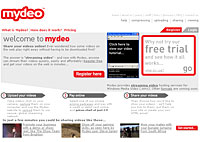 Mydeo, the UK consumer video streaming company, has teamed up with UK ISP Tiscali to offer streaming video sharing services to broadband users of the UK Tiscali Website.
Mydeo, the UK consumer video streaming company, has teamed up with UK ISP Tiscali to offer streaming video sharing services to broadband users of the UK Tiscali Website.
Available within the Community, Members and Technology areas of the Tiscali.co.uk site, the co-branded service will let users add home videos to their Websites, blogs or personal Webspace areas, and send streaming video emails.
‘Streaming is perfect for sharing home videos on the web because it allows users to show people their videos without giving the files away. Downloading not only means waiting to watch but, for the publisher, it also means you lose control of your content,’ enthused Cary Marsh, Managing Director and Co-Founder of Mydeo.
‘We know how important this is to our members sharing personal and family videos,’ Marsh added, earnestly.
The accent is definitely ‘family videos’ here. Unlike some of the other services that have sprung up since Mydeo first started, the video on it are definitely on the respectable side. It’s the sort of place you’d be happy to point your family to without them seeing anatomy shots or someone having their head cut off.
 Members will be able to stream their cinematic masterpieces on a pay-as-you-go basis, and will only have to shell out when they choose to upload a video. Users can pay in Euros, UK Pounds or US Dollars.
Members will be able to stream their cinematic masterpieces on a pay-as-you-go basis, and will only have to shell out when they choose to upload a video. Users can pay in Euros, UK Pounds or US Dollars.
Once on the server, members can blast out their captivating home videos in customised video emails to lucky recipients.
We’ve learnt that the deal with Tiscali is a one-way exclusive, i.e. Tiscali can’t use another video sharing services, but Mydeo can work with other ISPs. It’s our understand that Mydeo are in discussion with other broadband ISPs, who we’re told are showing a lot of interest in carrying the service.
‘We are very pleased to be able to bring such an exciting and innovative service to our users. Streaming video and broadband are a natural fit,’ purred a deeply chuffed Alex Hole, commercial director of Tiscali UK.
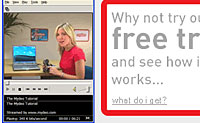 “Mydeo is really easy to use and offers lots of help and support for our members who may be putting video on the Web for the first time,” Hole insisted.
“Mydeo is really easy to use and offers lots of help and support for our members who may be putting video on the Web for the first time,” Hole insisted.
With the Mydeo service already integrated into the popular Windows Movie Maker 2 package, the process of uploading videos should be fairly straightforward for Windows XP users.
Mydeo are the only European supplier of streaming services to Microsoft Windows Movie Maker 2.
The company claims that their service lets the “humble home video maker” enjoy the “quality and reliability of a world-leading streaming network, something they would never have been able to purchase as an individual.”
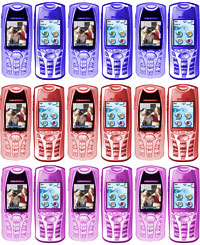 Market analyst Gartner reports that mobile phone sales have soared 22 percent compared to the same period last year.
Market analyst Gartner reports that mobile phone sales have soared 22 percent compared to the same period last year. In the Latin American segment, sales were up 46 per cent compared to last year, totalling 26.1 million phones units, while in Western Europe, big sales of 40 million phones were driven by customers upgrading their handsets.
In the Latin American segment, sales were up 46 per cent compared to last year, totalling 26.1 million phones units, while in Western Europe, big sales of 40 million phones were driven by customers upgrading their handsets.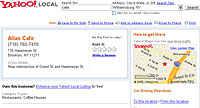 Using search engines has become the second most popular activity for Web users, according to new research from the Pew Internet & American Life Project.
Using search engines has become the second most popular activity for Web users, according to new research from the Pew Internet & American Life Project.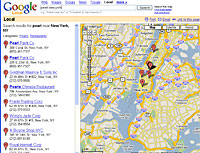 ‘Gen X’ surfers (29-40 year olds, not the Billy Idol-fronted band) were online the most (51 per cent), followed by ‘Gen Y’ users (18-28 year olds), ‘Older Baby Boomers’ (51-59 yrs old), ‘Younger Baby Boomers’ (41-50), ‘Matures’ (60-69) and, finally ‘After work’ (70+). We wonder who makes up these daft categories?
‘Gen X’ surfers (29-40 year olds, not the Billy Idol-fronted band) were online the most (51 per cent), followed by ‘Gen Y’ users (18-28 year olds), ‘Older Baby Boomers’ (51-59 yrs old), ‘Younger Baby Boomers’ (41-50), ‘Matures’ (60-69) and, finally ‘After work’ (70+). We wonder who makes up these daft categories?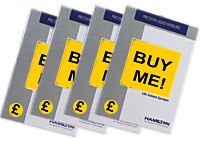 The Internet was supposed to herald in an age of paperless offices, online browsing and tree-untroubling electronic mail, but it seems that when it comes to flogging goods, the trusty old print catalogue still rules the roost.
The Internet was supposed to herald in an age of paperless offices, online browsing and tree-untroubling electronic mail, but it seems that when it comes to flogging goods, the trusty old print catalogue still rules the roost. The survey found that old fashioned catalogues remain one of the most effective promotional channels for generating online orders, with 60% of survey respondents currently licking stamps on catalogues and brochures to be sent to customers in an attempt to increase online sales.
The survey found that old fashioned catalogues remain one of the most effective promotional channels for generating online orders, with 60% of survey respondents currently licking stamps on catalogues and brochures to be sent to customers in an attempt to increase online sales. Additionally, the survey revealed that 55% of retailers planned to follow the annoying trend set by High Street stores and “extend” the Christmas buying period by encouraging consumers to buy earlier (If only we could “extend” the Christmas holiday period too).
Additionally, the survey revealed that 55% of retailers planned to follow the annoying trend set by High Street stores and “extend” the Christmas buying period by encouraging consumers to buy earlier (If only we could “extend” the Christmas holiday period too). Around 80% of consumers are expected to buy at least a quarter of their Christmas purchases online this year – up a mighty 15% over last year.
Around 80% of consumers are expected to buy at least a quarter of their Christmas purchases online this year – up a mighty 15% over last year.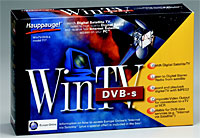 Hauppauge Digital have whipped out a new add-on card to convert a boring old PC into a multimedia-tastic satellite TV receiver.
Hauppauge Digital have whipped out a new add-on card to convert a boring old PC into a multimedia-tastic satellite TV receiver.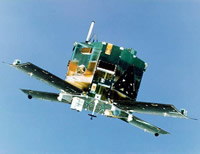 Freesat will be the satellite equivalent of Freeview,” said Yehia Oweiss, Managing Director of Hauppauge Digital. “Already broadcasting BBC, the service will be available to all UK households and bring free digital TV to the 25 per cent who are outside Freeview’s area. Consumers can buy our Freesat tuner now and enjoy many digital channels now, with more being added all the time.”
Freesat will be the satellite equivalent of Freeview,” said Yehia Oweiss, Managing Director of Hauppauge Digital. “Already broadcasting BBC, the service will be available to all UK households and bring free digital TV to the 25 per cent who are outside Freeview’s area. Consumers can buy our Freesat tuner now and enjoy many digital channels now, with more being added all the time.”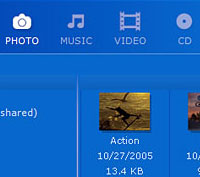 Sony have launched the PSP Media Manager for the PlayStation Portable, an iTunes-like application designed to make it easy to shunt music, movies, photos and other content off a PC and onto PSPs and synchronise PC content with the PSP.
Sony have launched the PSP Media Manager for the PlayStation Portable, an iTunes-like application designed to make it easy to shunt music, movies, photos and other content off a PC and onto PSPs and synchronise PC content with the PSP.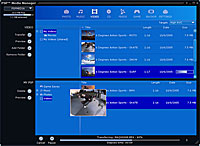 Supported image formats include .bmp, .jpg, .gif, .png, and .tif, with a bundled utility to backing up game saves to the PC.
Supported image formats include .bmp, .jpg, .gif, .png, and .tif, with a bundled utility to backing up game saves to the PC. The boxed version containing the USB lead and five free song downloads will be available form Sony’s Connect music from November 22 for $29.95 (~£17, ~e24), with the downloadable version already available (clearly without the USB lead – matter transfer via the Internet is being worked on) from the official Sony Media Software site for $19.95 (~£11, ~e16.5).
The boxed version containing the USB lead and five free song downloads will be available form Sony’s Connect music from November 22 for $29.95 (~£17, ~e24), with the downloadable version already available (clearly without the USB lead – matter transfer via the Internet is being worked on) from the official Sony Media Software site for $19.95 (~£11, ~e16.5).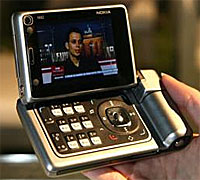 Nokia has announced three more Nokia N series multimedia devices, the Nokia N92 (the world’s first mobile device with a built-in DVB-H receiver), the Nokia N71 and the Nokia N80.
Nokia has announced three more Nokia N series multimedia devices, the Nokia N92 (the world’s first mobile device with a built-in DVB-H receiver), the Nokia N71 and the Nokia N80.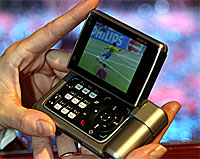 Using the built in software, users can also create personal channel lists, subscribe to TV-channel packages, set program reminders and interact through services such as voting, program feedback and additional web discovery.
Using the built in software, users can also create personal channel lists, subscribe to TV-channel packages, set program reminders and interact through services such as voting, program feedback and additional web discovery.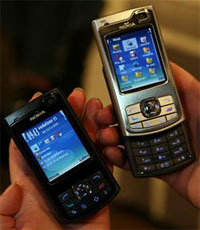 Sporting WLAN and 3G, the Nokia N80 is being touted as the world’s first handset to feature UPnP technology, and has the ability to be used as a remote control for wirelessly swapping content between PCs, audio equipment and TVs.
Sporting WLAN and 3G, the Nokia N80 is being touted as the world’s first handset to feature UPnP technology, and has the ability to be used as a remote control for wirelessly swapping content between PCs, audio equipment and TVs.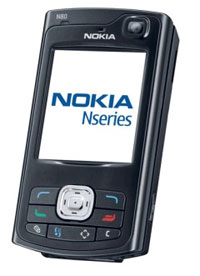 Photos snapped on the Nokia N80 can also be printed wirelessly to any UPnP-enabled printer or photo kiosk.
Photos snapped on the Nokia N80 can also be printed wirelessly to any UPnP-enabled printer or photo kiosk.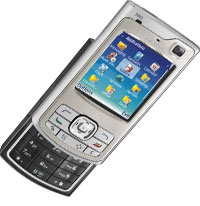 Storage comes in the form of 40 MB of internal memory, with support for miniSD cards of up to 2 GB.
Storage comes in the form of 40 MB of internal memory, with support for miniSD cards of up to 2 GB.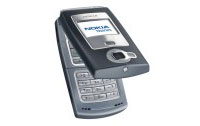 We could only find a teensy-weensy picture of the 3G clam phone as we went to print, but we can tell you that is has two displays and two cameras, one of which is a 2-megapixel camera.
We could only find a teensy-weensy picture of the 3G clam phone as we went to print, but we can tell you that is has two displays and two cameras, one of which is a 2-megapixel camera. Not satisfied with its already-almighty online presence, the BBC has launched the Film Network – a growing interactive showcase for new British filmmakers, broadcasting three new short films in broadband quality every week.
Not satisfied with its already-almighty online presence, the BBC has launched the Film Network – a growing interactive showcase for new British filmmakers, broadcasting three new short films in broadband quality every week.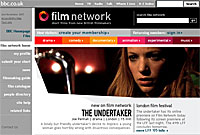 The Website aims to expose new talent and create a platform for some great films that are rarely seen elsewhere.
The Website aims to expose new talent and create a platform for some great films that are rarely seen elsewhere. Viewers keen to grab a slice of the free film action will first have to register on the site.
Viewers keen to grab a slice of the free film action will first have to register on the site. It should be noted that the BBC Film Network is not part of the currently in-trials
It should be noted that the BBC Film Network is not part of the currently in-trials  The best thing about Samsung’s press photos is that they always feature groups of attractive young ladies deliriously happy to be touching their latest products.
The best thing about Samsung’s press photos is that they always feature groups of attractive young ladies deliriously happy to be touching their latest products. Coming in two parts – the laptop and its detachable 19″ screen – we were confident that we’d be in for double the fun and, sure enough, we were rewarded with happy-clappy shots of two ladies near-ecstatic to be fondling the electronics.
Coming in two parts – the laptop and its detachable 19″ screen – we were confident that we’d be in for double the fun and, sure enough, we were rewarded with happy-clappy shots of two ladies near-ecstatic to be fondling the electronics. Happily, Samsung have had the nous to ensure that they used standard monitor connectors too, so that the laptop can be connected to a bigger screen (for giving a corporate presentation, for example) – and even the display can be used with a different PC.
Happily, Samsung have had the nous to ensure that they used standard monitor connectors too, so that the laptop can be connected to a bigger screen (for giving a corporate presentation, for example) – and even the display can be used with a different PC. Full technical details, pricing and availability is yet to be announced, but we can tell you that the laptop packs a whopping 19″ WSXGA+ (1680×1050) HDTV compatible screen and is powered by a Pentium M770 (2.13GHz) CPU.
Full technical details, pricing and availability is yet to be announced, but we can tell you that the laptop packs a whopping 19″ WSXGA+ (1680×1050) HDTV compatible screen and is powered by a Pentium M770 (2.13GHz) CPU.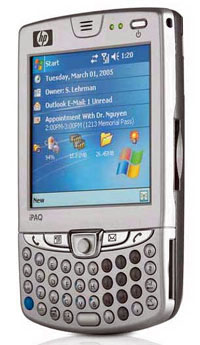 Helped by big European growth, global PDA (personal digital assistant) shipments whizzed up 21% in the third quarter of 2005, according to analysts Gartner.
Helped by big European growth, global PDA (personal digital assistant) shipments whizzed up 21% in the third quarter of 2005, according to analysts Gartner. The biggest shipment rise was recorded by Research in Motion’s (RIM) Blackberry device, growing 52.6% in the third quarter as the company extended its lead as the top dog worldwide PDA vendor.
The biggest shipment rise was recorded by Research in Motion’s (RIM) Blackberry device, growing 52.6% in the third quarter as the company extended its lead as the top dog worldwide PDA vendor.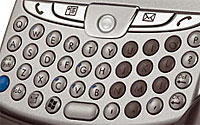 Overall, the Western European PDA market grew 53.4% in the third quarter of 2005, with 1.2 million units shipped.
Overall, the Western European PDA market grew 53.4% in the third quarter of 2005, with 1.2 million units shipped.